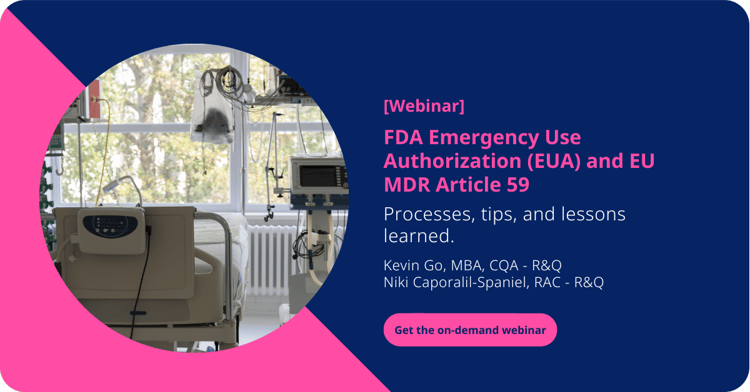FDA Emergency Use Authorization (EUA) and EU MDR Article 59
Processes, tips, and lessons learned.

FDA Emergency Use Authorization (EUA) process and EU MDR Article 59 to release devices needed for prevention and treatment of COVID-19
In response to the COVID-19 global pandemic, health authorities are taking the necessary steps to allow for greater access to and use of critical medical devices and PPE that are in short supply. However, some manufacturers lack the necessary regulatory approvals needed to make their medical devices/PPE available. In situations such as these, both the United States (FDA) and European Union (European Commission) have legislation in place to help bring these critical products to patients and healthcare workers for emergency applications.
In the United States, the US FDA has invoked the Emergency Use Authorization (EUA) authorizing the use of an unapproved product or an unapproved use of an approved product, provided that other statutory criteria are met.
In the European Union, Article 59 of the EU MDR (2017/745) can be used where the European Commission is responsible for identifying and authorizing certain medical devices and PPE that may be sold without CE Marking during the public health emergency and market access is granted individually by the Competent Authority of each member state. The EU has issued an implementing act restricting export of PPE from the EU and recommended conformity assessment procedures within the context of the COVID-19 threat.
In this webinar, we’ll discuss both emergency application processes, provide answers to the many questions we've received, and share tips and lessons learned from our experiences.
Agenda:
— FDA EUA Process
- Detailed process
- How is it different from the 510(k) process? Discuss Medical Devices and IVD’s.
- What are the basic requirements for the manufacturer, for example QMS, FDA registration, supplier controls, and post market surveillance to name a few? And what if a device fails?
- What happens after the crisis? Is a 510(k) needed to continue commercialization?
— EU MDR Article 59
- Detailed process
- How is it different from traditional CE marking?
- What are the basic requirements for the manufacturer? Will the manufacturer be audited?
- What happens after the crisis? Is the CE marking still valid?
— Tips and lessons learned
Presenters
Kevin Go, MBA, CQA – Senior Engineer (former FDA)
Regulatory & Quality Solutions (R&Q)

Kevin has experience working in both the public and private sector, as well as various-sized organizations ranging from small start-ups to multi-national corporations. He recently joined R&Q Solutions, after working at FDA for over 5 years. In his time at FDA, he served as a Lead Reviewer in the Division of Orthopedic Devices, where he reviewed numerous pre- and post-market submissions. Additionally, he also served as an Advisor to the CDRH Innovation group and Payor Communication Task Force, where he provided early regulatory and reimbursement assistance to small businesses. Kevin has Bachelor of Science in Biomedical Engineering, a Masters in Business Administration, and CQA certification.
Niki Caporali-Spaniel, RAC – Principal Specialist
Regulatory & Quality Solutions (R&Q)

Niki Spaniel has been a key contributor to the success of R&Q and its clients since 2010. With over twenty years of medical device industry experience, including several years in lead roles in quality management system creation and maintenance, she has acquired extensive skills and experience in project management, clinical trials, quality management system development and implementation, complaint handling and quality auditing and training. Niki’s expertise also includes regulatory affairs in which she has provided both strategic and hands-on support for various regulatory submissions including IDE’s, Pre-Submissions, and 510(k) for Class I, II, and III devices. Niki is also skilled in technical writing and has used this along with her regulatory knowledge to develop clinical evaluations reports in support of products sold in the EU.